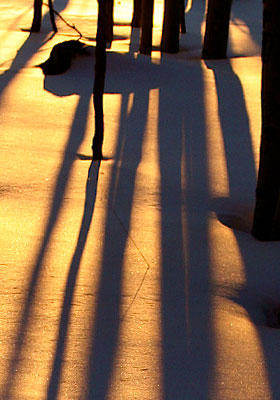Posts Tagged ‘living today’
Wednesday, March 23rd, 2016
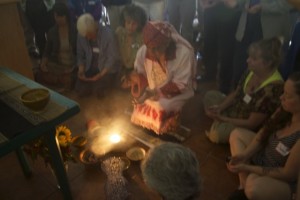
The smoke from the copal grew thicker in the room, as Apab’yan fed the small container fire with the granules of incense, and his prayers. People seated around him and behind him prayed too, mesmerized now by the hypnotic chanting in the Mayan language, punctuated by English phrases so we could all track where the prayers were being directed.
The room was darkened in order to suggest the atmosphere of the caves where this water ceremony is usually performed. A bowl of water resting on the table received the blessing, and participants would eventually be offered sips of it, as in communion. Finally, roses were dipped into the water and used to shake drops of water on all those gathered.
It was a potent blessing, because the intimacy and power of ritual transcends cultures, language differences and even philosophical details. Spirit is Spirit in any language. And the language of Spirit is ceremony.
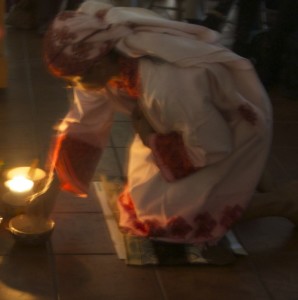
Apab’yan Tew a Guatemalan Maya Daykeeper and spiritual guide, came to the U.S. as a guest of Kenosis Spirit Keepers, a non-profit headed by Carla Woody. Her spiritual travel programs bring North American people together with indigenous leaders. Whether in Hopi land, Peru, Bolivia, or Chiapas, Mexico, the traveler experiences first hand the reality that we are one.
In this case, a crowd of about fifty gathered at St. Philips in the Hills Episcopal Church in Tucson for a special event co-sponsored by Tacheria Interfaith Spirituality Center. Apab’yan taught us a bit about the Maya worldview, and then graced us with a water ceremony never before performed outside the mountain caves where foreigners are not permitted.
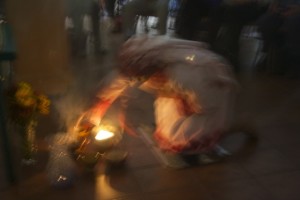
And what was the result? Why do indigenous people continue to do ceremony, and what can we gain from participating?
First, there is a palpable power, a felt presence. It is both humbling and empowering. It is a mystery, summoned by a humble shaman.
Ritual and ceremony go beyond words. Through work with the elements: fire, water, smoke, and sacred objects, an atmosphere of mystery took over our rational minds and transported us to another way of being. The sounds of singing and chanting evidently impressed the birds outside, since they began to sing in response.
Culturally we are starved for ritual and ceremony and for experiences of awe and wonder. Indigenous people from all over the world continue to make such experiences central to their lives. We can learn from this.
You don’t have to be a daykeeper or a shaman or a spiritual guide to perform ceremony. Create a simple ritual you can do in your own home or in the back yard. Choose a surface that will serve as an altar. Decide how you’ll make sound: with a drum, a rattle, or with your voice. How will you add fire? A candle will do. And water? Just fill a small bowl. Place stones or sacred objects of yours in an arrangement. Say a prayer. Sing a song of praise.
Apab’yan teaches that this is a way of giving back, when we have received so much. He learned this from his village in the Guatemalan highlands, where people have very little. Gratitude doesn’t cost a cent, but it’s a way to repay whatever spirits you’d like to thank for all your blessings.
Tags: Apab/yan Tew, Carly Woody, Kenosis Spirit Keepers, living today, spiritual practice, Tacheria
Posted in Uncategorized | 7 Comments »
Tuesday, August 25th, 2015
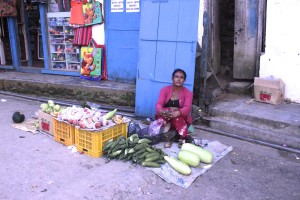
Seeing the global markets tumble is as unnerving as an earthquake. Beyond questions like, “Will I be able to retire?” and other understandable, personal fears, lie other more global and cosmic ones.
We’ve long suspected that the current way of running the world is not sustainable. And we know that if something isn’t sustainable, it won’t be long before it begins to crumble. We’ve seen institutions and systems crumbling all around us. With them, we can watch the crumbling of our illusions that the very ground beneath us and the climate around us are stable.
One way to frame this is to say that the energy responsible for the trouble we’re in is the energy of the wounded masculine. The predatory, win-at-all-costs, short-term way of “winning” through force, oppression and marginalization is the masculine in its most harmful form.
Like the masculine, the energy of the feminine has many forms. She is responsible for birth, but also death. Her realm is all matter and the passages it goes through: from seed to flowering, to dissolution, to decay, to rebirth. And so in many traditions, she has both a creative and a fierce aspect.
She is sometimes Kali, who wears the necklace of skulls. She roars onto the battlefield with a sword and cuts off heads of everything false. With the dead bodies strewn around her, she calmly sits down to nurse her baby.
In western culture, images like this one disturb most people. When I traveled in Nepal, I saw shrines to the Divine Feminine in her fierce form everywhere. In the midst of the marketplace, many of them were covered with filth, and then strewn with flowers. They were honored just as they were, right in the center of human activity. They were not neat or pristine or protected. Many of them were destroyed in the earthquake. They are icons of the Hindu faith in the process of death and rebirth, the faith in destruction of the false as a path.
And so I look at this photo I took of a Nepalese woman in the marketplace of a little mountain village, and I wonder some things. How did she survive the earthquake? Can she still farm her vegetables and support her family? How well is the world and the marketplace supporting her? Is her faith sustaining her?
She is a reminder to me as I glance at the paper or hear the frantic debates in the media. What would be the saving grace of the Divine Feminine in this situation? What are the falsehoods the fierce feminine would destroy? What is trying to be born?
We know that our economy is largely built on a house of cards that is too false to be sustained. Our own welfare is complicated. We are in debt to the Chinese, and everyone is in debt to someone else. So the falsehood of the “dollar” will collapse at some point.
And what is trying to be born? Wall Street may be the most difficult arena for this, but the Divine Feminine in her Creative aspect is a birther, a nurturer. She is at the heart of Creation, and is the heart of Compassion.
And so as she works on Wall Street, she might be seeding a question: what would a compassionate economic system look like? What would truth look like translated into economic terms? It’s time to consider these questions.
Those men and women who are devoted to the Divine Feminine within us all can be devoted now to her re-emergence in the world. She is surely at work in the massive shift we are experiencing. Let us take a stand for her. Surely that could be the revolution that could save us all.
Tags: consciousness, Kali, living today, the fierce feminine, Wall Street
Posted in authenticity, caring for the earth, conscious evolution, consciousness, death and new life, divine feminine, feminine leadership, heart-centered leadership, policy making, shifting how we see, shifting paradigms, Tools for seeing ourselves, women's empowerment | 5 Comments »
Wednesday, August 12th, 2015

“This world is but a canvas to our imagination.”–Henry David Thoreau
When I traveled in Nepal, Tibet and Bhutan last fall, I was of course struck by the wealth of sacred art. The particular ceiling in this photo was taken in a private home, so these arts are not relegated to skilled monks or to antiquity–they are still practiced by village craftsman. (Granted, in Tibet these craftsmen are an endangered species, since the Chinese are co-opting and controlling everything about Tibetan culture.) Imagine living in a home where your neighbor painted this extraordinary piece of art.
How would looking up at such a ceiling every day affect your vision of the world?
I think sacred arts have been created for many reasons, but one of them must be that the piece of art preserves the vision of the sacred world–and the invisible one–and passes this vision forward, preserving it as part of reality.
When we create any kind of art we are preserving or encoding a view we have of a certain aspect of reality. In that sense, what we saw when we made the piece is what we get as a future.
There’s another sense in which “what you see is what you get.” All the theories that abound today about creating your own reality are based on the idea that our thoughts can become manifest. And our thoughts are largely visual. It’s as though we have a vision–whether it be of ourselves coming down with a cold, or reuniting with a friend–and often we are either grabbing a tissue or answering the phone, delighted at the “coincidence.”
Vision has been proven to affect performance so strongly that most serious athletes visualize that perfect high dive or ski run. Since I’m recuperating from foot surgery and don’t want all the muscles in my left leg to forget they’re muscles, I’m picturing myself dancing, hiking and walking on the sand. Science tells me that my muscles will believe they’re really doing it.
The link between vision and manifestation works from the inside out, and also from the outside in. When I traveled to the Berlin Wall in the ’60’s, I was shocked to see the wall, even though I had studied about Berlin and knew intellectually all about the efforts to divide people from each other. We know there is a big difference between intellectual and emotional knowing. Once I had seen it, I knew I would always be against such walls and would take a stand for what unites rather than divides us. The seeing changed my mind and heart, and became part of me. What I saw was what I got.
So how can you use this notion that what you see is what you get? I can think of three ways:
1. You can purposefully go on treasure hunts for beauty. With your camera or just your physical eyes, you can collect images that will become part of you, in mind, body and spirit.
2. When you see something disturbing, do a re-frame. Instead of focusing just on how disgusting or sad or scary something is, you can ask what the deeper purpose of your seeing could be. That way, you will literally “see” this scene differently, as if you put a filter on your mental camera.
3. You can point out beauty to others. Everyone does not see the subtleties of the pearly light on the foggy mountains. Some people just see grey and “bad weather.” You can always ask if someone sees how many different shades of green there are in the forest. It may literally expand their vision, and thereby their experience.
Beauty is good medicine. If what we see is truly what we get, then I’ll choose beauty any day of the week.
Tags: beauty, consciousness, creative imagination, creativity and empowerment, living today, perception, Photography, spiritual practice, The Beauty Way, Through A Different Lens
Posted in Imagination, shifting how we see, shifting paradigms, spiritual practices, The Beauty Path, Tools for seeing ourselves | 5 Comments »
Thursday, April 16th, 2015

The Hopi people we met in Arizona on a spiritual tour with Carla Woody (http://www.kenosis.net) allowed us to see and photograph a petroglyphic symbol of a blue star that appeared long ago, to signal their way home. The story they told us was that when they emerged through a sipapu or opening in the earth in northern Arizona, they met Masau, the guardian of the earth, who told them they could inhabit this world if they would abide by his instructions.
He told them to make migrations into the four directions, and after spreading far and wide he told them they would be signaled back to the place of their emergence.(http://en.wikipedia.org/wiki/Hopi_mythology) According to the Hopi records they inscribed into petroglyphs and according to their oral tradition, they migrated far into Alaska and Canada, west and east to the oceans, and south into Central America. Some of them stayed there and became the Mayans; others stopped in the pueblos on the way back and created communities there. When the blue star appeared, some of them knew if was time to return to Northern Arizona, the place of their emergence, and to form villages there. These are the ones we visited.
It’s a powerful story, and one that traditional Hopis believe is truth, not myth. They are still following their original instructions and living simple lives, planting corn (some of them still by hand, with a planting stick) and faithfully continuing their kiva ceremonies. When the faithful ones pass on, they join the katsina spirits, who live on the sacred San Francisco Peak, near Flagstaff. Every winter solstice they dance and do ceremony to welcome the katsinas back to the villages. Every summer solstice, they give them a ceremonial sendoff.
In the photo above, taken on Hopi land, you can see an ancient symbol of the migrations–three of them–in a spiral that took thousands of years. To the right, you see a person, and in the middle you see the blue star.
The Hopi have come home. Life at home is not easy for them. Promises have been broken and they have suffered and sacrificed. But they are staying true to what is central to them, what has heart and meaning. That is the place home is–not just a physical location.
Where is home for you? When you arrive at the center of your being, which I know you have, what signs do you have that this is your inner home? Even if there are uncomfortable things, sacrifices, even suffering that has been involved in you returning home, hasn’t it really been worth it? Isn’t it what life is all about?
What is the “blue star,” the signal that tells you it’s time to return to your real self, to cease your wanderings, to return to being the one you where when you emerged from the womb and the one you will be the day you pass from your body? Is there a call, a signal that tells you it’s time to make your way to the center again? How do you hear or see or feel that call?
Never feel lonely about being called to return. You know that even if it doesn’t seem like it when you’re out in the grocery store or at the movies, other people are wanting to return home as well. Every human, I believe, has a longing for this. And I, for one, am grateful to the Hopi people for reminding me that right here in our own back yard, we have an example of spiritual lives grounded in significance.
Tags: living today, managing change, Pamela Hale, Photography, the Hopi traditions
Posted in conscious evolution, learning from the Hopi people, Photography, seeing oneself, shifting how we see, Tools for seeing ourselves | 11 Comments »
Thursday, April 16th, 2015
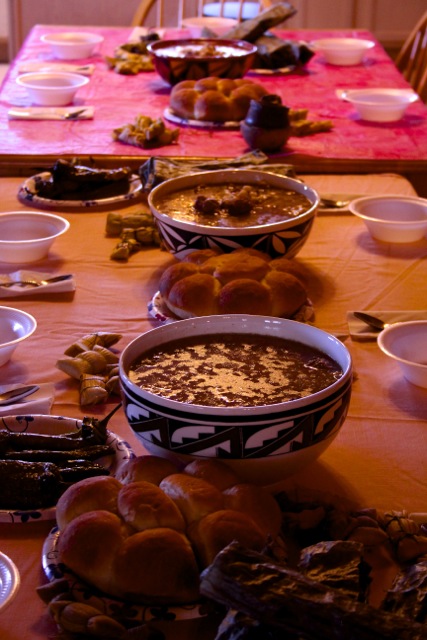
I am still digesting a precious, bountiful and nutritious feast that has fed me in ways I can’t yet articulate well. In future blogs, maybe I’ll find more words to describe what I’ve gained from the spiritual travel to Hopi land with Carla Woody, spiritual mentor and founder of Kenosis Spirit Keepers, a non-profit dedicated to preserving and sharing indigenous wisdom. (kenosis.net) For the moment, Let me share with you the visible elements on this bountiful table.
On a literal level, this feast was prepared for us by Charlene Joseph, a Hopi woman from the village of Moenkopi. We were welcomed into her home to learn about the Hopi way of life, which is all about Spirit. Perhaps you can’t see Spirit in the photograph, but it is the major ingredient–the primary flavor in every event, every “dish” that is part of her family’s life.
This feast is a tradition the morning after the night Kachina dances, which we were privileged to attend. Char’s husband, Harold Joseph, is a leader in his clan and has successfully negotiated many improvements contributing to Hopi life. He generously shared with us the elements of spiritual life that can be shared, since some practices and beliefs are kept within the hearts and minds of the men who lead the kiva ceremonies at the center of the traditional Hopi way.
The big bowls contain the traditional hominy stew that Char began making the day before, along with yeast rolls that the women in our group helped make. My husband Jon loved the fried dried red chilis, as well as the fresh green ones, since nothing is too spicy for him. I especially loved the tiny tamales tied in a traditional form and made by Char and Harold’s daughter, who took some into the kiva with the other unmarried girls who dressed up to take the dancers special food and have privileged seating within the kiva.
Another platter contains piki bread, which unmarried women make for their puberty ceremony. It is very thin sheets–almost like filo dough–that they process on a stone tablet, as has been done for centuries.
Having been fortunate enough to travel far from home and to learn from many cultures older than our American one, it struck me again that the ancient Hopi culture is right here in my own back yard. It is an island surrounded by Navajo lands, east of the Grand Canyon. But from my immersion in Hopi ways for a short week, I feel I’ve been far away, out of space and time. I’ve been nourishing myself from the generous table of Native people willing to share a way of life that is inspiring, courageous, and an example for us all.
As I digest and integrate my learnings, I’ll be sharing with you some of the “translations” from the Hopi world to the one the majority of us inhabit. There are adjustments and commitments we can all make that could align us more directly with Spirit, help us avoid some of the potential disasters Hopi people warn us about, and support us as we attempt to live out the kind of truth that can change our lives and perhaps even save the world.
Tags: Carla Woody, consciousness, Hopi, Kenosis, living today, managing change
Posted in caring for the earth, consciousness, learning from the Hopi people, shifting how we see | 13 Comments »
Saturday, January 10th, 2015

As I weep over the multi-layered tragedy in France, I am also aware of pain in other areas, both personal and institutional, all around us. The pain raises that age-old question once again, a question that is more dramatic than ever in this age where we are exposed to global events in the media in a very tangible way. What is our role when we see suffering, and how do we handle our feelings about it?
When I move away from the huge issues surrounding terrorism, religious intolerance and violent fundamentalism and concentrate on my own life, certain themes become clear. Some examples…
Clients always come to me with a story, and I come to myself with my own stories. All of us want these stories solved, and we usually approach them by trying to figure them out. When we get engaged on that level, we usually get caught in a loop, going round and round. I tell my clients and myself, “The answer does not lie within the story.”
My shamanic training taught me to be an ally for clients by looking at their story “through a different lens.” Instead of engaging with the drama, my job is to hold space for a larger possibility.
The story has brought the client to a crossroads, where there is a decision to be made. Do I take the same road I’ve always taken when issues like this come up, or do I take a road I’ve never taken?
I ask them to choose the road not taken, which is to engage not from the “smaller” self that becomes victim to every drama, but from the larger self which knows better. This self can look at things from a larger consciousness, from the soul level. From that level, there is a big, long journey visible.
And so the larger self can say about the current tragedy, “Of course you have these emotions about it.” And then that soul-self can add, “And what could be good about all this?
On a personal level, what could be good about a tragedy is that someone might respond to it by deciding to go down the road of truly seizing their life and going after their heart’s desire. Now there’s an exciting opportunity!
On an institutional level, when things fall apart, the good thing could be that the leadership sees old patterns that are not sustainable and embraces a larger vision that really serves their dream and also serves the planet. Hooray!
And on a global level, the good thing about a terrible tragedy is that it brings things to light that have not been recognized by the general populace, and they have the chance when they see what’s wrong, to stand for a new and brighter road to a different future.
The crossroads in all three situations present the choice between submitting to something that may feel like fate, or seizing our soul’s true destiny. I would like to hold the vision of that destiny, and to take a stand for that.
I do that through spiritual practice that reminds me of who I truly am and of my unity with unseen spiritual support. And I hold energetic space for change to flow through me and through others, who will make their own choices.
This is a tough discipline for sure. But that is what we are being asked to do, and why we may be on the planet at this time. So join me in responding to it all with–along with our natural grief and compassion–a larger and more powerful force that holds it all.
Tags: consciousness, creativity and empowerment, living today, managing change, meditation, non-attachment, perception, spiritual practice, The Beauty Way, transitions
Posted in conscious evolution, consciousness, managing change, meditation, overcoming fear, self-healing, shifting how we see, shifting paradigms, spiritual practices, Tools for seeing ourselves | 2 Comments »
Tuesday, December 2nd, 2014

I had the privilege of traveling to the little kingdom of Bhutan recently, and one of the many gifts I received from that visit was the inspiration to spread the word about GNH. For Bhutan’s policy-making is guided not by the GNP (Gross National Product) but by GNH–Gross National Happiness.
It’s more than just a cute-sounding idea. There are documents outlining the four pillars, nine domains, and metrics for weighing and measuring progress. (http://www.grossnationalhappiness.com/) This little country of only 750,000 people is a model for a self-chosen set of values based on something we all chase: no, it’s not money; it’s happiness!
Thanks to our trip organizer, Narayan Shrestha (founder of the non-profit, Helping Hands), we were privileged to have a private dinner with the mayor of Thimpu, the national capital. Kinlay Dorjee seems humble, sincere, and clearly devoted to increasing the GNH in the capital and throughout the country. He spent some time introducing us to the four pillars, which are:
1. Good governance
2. Equitable and sustainable socio-economic development
3. Preservation and promotion of cultural heritage
4. Preservation and promotion of the environment
Pretty wonderful measures for policy-making, right? Let me backtrack to the inspiring back story.
In the 1970’s His Majesty the Fourth King Jigme Singye Wangchuck observed that economic growth had become the measure of growth and success across the world and at both collective and personal levels. Given the costs we are paying for this ideology, this enlightened king decided he would focus on a different set of values.
He came up with GNH, based on the belief that collective happiness of a society is the ultimate goal of governance. His legacy to his son, the current fifth King Jigme Kheser Namgyel Wangchuck, was the job of creating an operational framework for the growth of GNH in his country.
Finding that the four pillars were not complete enough, the Royal Government of Bhutan initiated the Good Government Plus (GG+) in 2005. Then the Centre for Bhutan Studies and GNH Research worked on indicators that now classify the values into nine domains. They are:
- Psychological wellbeing
- Health
- Education
- Time use
- Cultural diversity and resilience
- Community vitality
- Good governance
- Ecology
- Living standards
Can you imagine a day when your government might ask if these nine domains are being addressed before deciding on a policy? For example, what if deciding on a policy for immigration involved asking, “What policy will increase cultural diversity and resilience?”
Can you imagine a day when corporate boards and executives might ask themselves how happy they and their employees and customers are, using these nine domains? How are corporate policies affecting the health domain, for instance?
And can you imagine a day when you might ask yourself if the decisions you’re making in your own life are taking these nine domains into consideration? Is that decision you’re considering going to affect the ecology of the planet? Your relationship to ecology will actually affect your happiness.
Some evidence I saw that these measures are working in Bhutan: the clean, sparkling rivers, which were like something out of a dream. Plastic bags are illegal; stores give out fiber bags. Tobacco is illegal and you cannot bring it into the country. People wear traditional dress–the men wear elegant robes over dark or argyle socks and dark shoes. The women wear lovely long skirts topped by jackets with a shawl collar often in a contrasting color. There is only a small military presence. Buddhist temples and other historical and cultural sites are beautifully preserved, and prayer flags fly everywhere there is a holy site or particularly stunning view.
Of course the country still faces challenges. But I was struck by the spiritual underpinning or energy, if you will, that was palpable everywhere. I felt an air of kindness, an atmosphere of reflection, an attitude of appreciation. This doesn’t stem from isolation; even monks were talking on cell phones. But it felt as if people had it straight that technology was not the end point. What they’re after is working with nature and with our own gifts, promoting what every human longs for: happiness.
Tags: Bhutan, consciousness, creativity and empowerment, Gross National Happiness, inner peace, living today, managing change, The Beauty Way
Posted in caring for the earth, conscious evolution, consciousness, creativity and empowerment, happiness, loving ourselves, managing change, new life, nourishing ourselves, policy making, shifting how we see, shifting paradigms, The Beauty Path | 7 Comments »
Sunday, March 18th, 2012

I remember flying along this gorgeous coastline in Baja, Mexico, with my husband Jon. It was before I got my pilot’s license, and so when he urged me to stop photographing and take the controls, I got instant butterflies. 95% of me wanted to fly, but the 5% that was terrified had the capability of ruining everything.
This makes me think of the beginning of my career, when I was a classroom teacher worried about maintaining discipline. Even on days when I had 95% of the class involved and focused, I was always afraid of that 5% that might take those controls away from me.
If “flying” is a metaphor for the 95% of us that knows how to break free of gravity and soar, we still have to learn to deal with the 5% that suspects we might crash at any moment. I call this “communicating with the controllers,” which is Lesson 5 in my book, Flying Lessons.
The challenge of this lesson is dealing with negative feedback. That might include the kind of inner voice I heard when my husband urged me to take the controls and I was afraid I couldn’t do it. Or, it might be outer feedback, like the kind I would get from disruptive students.
I would submit that our reaction to both kinds is fear: fear of the fear we feel, or fear that we will not be able to stay in control. Or fear that we were incapable all along; thinking we were was just a lie. And fear can hijack a good intent, a calm mind, an open heart and a good experience.
The lesson I learned from Clio, my flight instructor, was about discernment. Which voices are telling the truth that will keep you safe and set you free? And where is your true voice, which you need to use when standing up for yourself is the answer.
Here’s a summary of Clio’s advice:
1. Be kind. The 5% may be afraid. Fear can make them (whether they are outer or inner voices) say terrible things. Take that into consideration.
2. Be fair. Remember, they are the 5%. Are you listening to the 95%, or are they just invisible, their hands folded politely on their desks, their voices muffled behind their modest smiles…What if you asked them to raise their voices in song?
3. Ask for help. Ask your partner, your friend, your angels, your guides, your God, whomever you trust the most for help. For listening. For caring. For hugs. For company. The 95% of the controllers are trying to help you survive.
4. Keep the whole journey in mind. Remember, it’s this part that is hard. The big picture journey probably has a much more beautiful arc to it.
5. Remember, everything is relative. You sometimes think the world is coming to an end. When yours looks like that, so does the larger one. Still, there are those other times when all is glowing, when the leaves of every tree are on fire with sunlight, and when the moon is huge and white and all-knowing. When life is holy. When you are perfect, just as you are.
Tags: consciousness, Flying, Flying metaphor, inner peace, living today, managing fear, perception, Photography, Self, spiritual practice, ups and downs
Posted in aviation, bringing out your gifts, children as teachers, coaching, conscious evolution, consciousness, creativity and empowerment, Flying, happiness, healing, loving ourselves, nature as mirror, nourishing ourselves, Photography, seeing oneself, self image, self-healing, shifting how we see, shifting paradigms, spiritual practices, Tools for seeing ourselves | 2 Comments »
Tuesday, January 24th, 2012

Sometimes I cringe when I meet someone who asks me what I do. Answering either “life coach” or certainly “energy medicine practitioner” or for sure, “shamanic practitioner” can lead to immediate Eyes Glazing Over Syndrome.
Sometimes I do better when I tell a client story, but the best approach is asking questions. Like, “Have you ever had the feeling that something is missing in your life, even if you’ve read a lot of books, had therapy or tried meditating?” (At this point, I am checking for “Woo Woo, Checking Out Now Syndrome.)
But I persist. “Do you ever feel confused about your purpose? Or feel that your passion for your life has gone flat?”
Even though such complaints are vague, most of us have experienced them. Someone who says “Absolutely not” would probably not want life coaching or any personal development enrichment.
In reality, we have all experienced feelings that some might call burnout, and others might describe as being out of balance. Even someone who has never quite found that path, that center, usually can recognize these symptoms. The vocabulary isn’t important. And so…what?
I would call the feeling of being in our center, on our path, feeling passion and purpose “the pilot’s seat.” And I would say that the one who has taken the pilot’s seat in such moments must be the essential self. The one who is all about our life force, or soul.
Sometimes the essential self manages to take the pilot’s seat “by accident,” or really without our effort. In those moments we might call grace, we simply know and we simply are.
When you’ve been there, it’s painful to be dislodged from the pilot’s seat, or to have it commandeered by sub-personalities, or by the ego, who is not well-connected to essence.
Sometimes just the awareness of being off-center is enough to correct the situation. Other times, we need help. We need tools. Here are some to consider:
- Deep talk, soul sharing with a friend or advisor who listens well
- Traveling into invisible realms for guidance, through meditation, prayer, dreams or shamanic journeying—or my Sand Spirits Insight Cards!
- Any breathwork or meditation system that leads you back into your heart
- Asking the Great Mystery for help
- Work with changing old beliefs and releasing old patterns
If any of this resonates with you, I invite you to call me for a complementary phone consultation. Or if this has helped you remember your own tools, please add your comment!
Tags: Being, centering, centering techniques, consciousness, Essence, Flying, Flying metaphor, inner landscape, living today, managing change, meditation, perception, Photography, Sand Spirit Insight Cards, spiritual practice
Posted in bringing out your gifts, centering techniques, coaching, conscious evolution, consciousness, Dreams, Flying, happiness, healing, Imagination, inner landscape, meditation, mindfulness, Photography, returning to essence, Sand Spirit Insight Cards, seeing oneself, self-healing, shifting how we see, shifting paradigms, spiritual practices, Tools for seeing ourselves | No Comments »
Tuesday, January 3rd, 2012

When I walk on the beautiful land in the Sutherland Valley, beneath the Catalina Mountains, the land reminds me that Mother Earth has a heartbeat, a rhythm. Being in nature attunes my body to her rhythm and reminds me of my own natural pace. So does meditation—it is a way of stopping to check in with the Source, and with my own body/mind, and re-calibrating.
I need to change my “attitude,”—an aviation term for the angle of the airplane– to pull the nose of my airplane up a bit and slow my speed.
When I think of the idea of slowing my pace, my “small mind” immediately panics at the thought. What will I miss? What will I not accomplish?
Fortunately my “larger mind” responds by asking, “Where are you going so fast? What is your destination or goal that is so crucial? Isn’t the journey the point?”
My small mind says nothing.
I remember Thich Nhat Hahn’s cautions about our pace, his advice about mindful walking and mindful eating and avoiding multi-tasking.
My small mind points out how many things I accomplish by multi-tasking. Is that really true? Recent research points out that our brains don’t operate at maximum efficiency when we do more than one thing at a time. Maybe we are sacrificing focus, intensity and depth of thought, excellence in problem-solving.
Perhaps I suffer from the aviator’s dreaded plague, “get-there-itis,” the disease that leads to unwise decisions like flying too late, or into bad weather, or when sick, or in conditions outside our expertise. If we crash, we might ask ourselves what was so important about that destination and how much time we really saved.
If I take time to gaze out the window, perhaps I’ll really see something like the scene in the photo of the water and cloud formations along the Sea of Cortez. What’s the hurry, really?
These are thoughts each of us must bring to consciousness as we pilot our way through a year that may challenge us to drop old patterns, to take responsibility for our own energy, to ask treasured family and friends to support us as responsible pilots who have taken the left seat. We may not be able to manage the strong winds of life, but we can manage ourselves.
What are your thoughts? Interact with us at Facebook.com/FlyingLessons!
Tags: Being, consciousness, Flying, Flying metaphor, inner peace, living today, managing change, meditation, musings, Nature and the soul, new life, own pace, Photography, spiritual practice, The Beauty Way
Posted in aviation, Being, coaching, conscious evolution, consciousness, Flying, happiness, healing, health, inner landscape, loving ourselves, managing change, meditation, mindfulness, new life, not doing, nourishing ourselves, Photography, returning to essence, seeing oneself, self-healing, shifting how we see, shifting paradigms, spiritual practices, The Beauty Path, Tools for seeing ourselves | No Comments »












